POWER SUPPLY NOISE Encountered by guitarists using power supplies to power their effects pedals
SOUNDS LIKE lots of different things (sorry) 🙁
 Guitar Noise Manual by PedalSnake®
Guitar Noise Manual by PedalSnake®
.
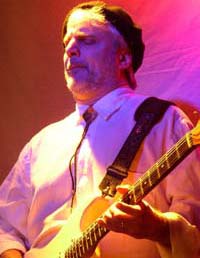 Jody Page, PedalSnake’s inventor and lifelong pro guitarist, is an electrical engineer (a member of NASA’s Space Foundation Hall of Fame, no less) with special training in electrical noise. In the Guitar Noise Manual, Jody starts by breaking down guitar rig noise into 6 types:
Jody Page, PedalSnake’s inventor and lifelong pro guitarist, is an electrical engineer (a member of NASA’s Space Foundation Hall of Fame, no less) with special training in electrical noise. In the Guitar Noise Manual, Jody starts by breaking down guitar rig noise into 6 types:
1) BUZZ 2) HUM 3) HISS 4) DIGITAL NOISE (WHINE) 5) POWER SUPPLY NOISE 6) CABLE MICROPHONICS
For each noise, Jody explains its causes, then offers a targeted set of solutions. Also included are several helpful articles on general best-practices for noise reduction.
.
Dealing with POWER SUPPLY NOISE
Contents
So What’s the Deal With POWER SUPPLY NOISE?
What can cause power supplies to be noisy?
A power supply too close to a pedal
.
Before We Start…
.
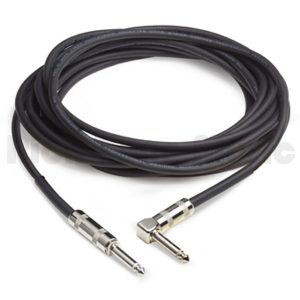 Make sure you have a good guitar cord
Make sure you have a good guitar cord
By good, we mean “not broken”. A simple jiggle test at both ends will usually tell you. Then consider…
.
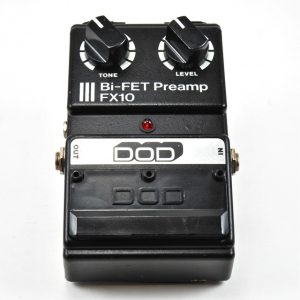
Boosting your guitar signal
Right away this can strike a lethal blow to any noise that might crop up. Anyone and everyone should do it. See Improving Signal-to-Noise Ratio (SNR). With a hotter guitar signal, you can…
.
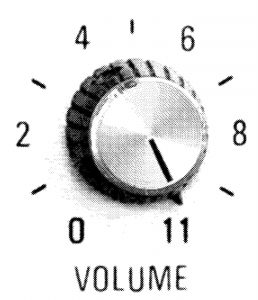 Reducing your gain
Reducing your gain
Gain is not free. The more gain you have, from all pedals and amps, the more noise you will have. Amps at 11 can give you that extra edge, but you may be just as happy (and quieter) at 9.
So What’s the Deal With POWER SUPPLY NOISE?
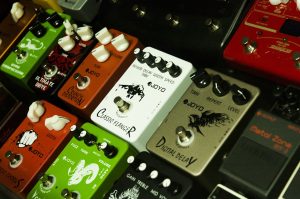 .
.
Power supplies are most often used by guitarists for powering effects pedals.
The good ones should be quiet. But even the good ones can cause noise if not used properly.
.
Now right here, before you $ay “ju$t get a $180 board-mounted power $upply” (we’ll get to thi$), just $low your roll a bit and $ee if there may be a more cost-effective way.
.
When power supplies are the cause of noise, the noise can be BUZZ, HUM, HISS, or even sound like digital noise (whine).
But noise that occurs when powering pedals is not always due to noise from the power supply itself.
So you should troubleshoot first.
- Start with no pedals or power supplies, just the guitar plugged directly into the amp.
- If things are quiet, add one power supply powering one pedal.
To ensure you aren’t overloading the supply (see below), just add one pedal with each supply.
.
- If you have more than one supply, add another pedal and supply, and so on.
- If you add a supply and hear noise, then you probably have found your culprit.
- To make sure it is the supply and not the pedal, try another pedal on that supply, then try another supply on that pedal, etc.
.
If you do not suspect the power supply, then try to identify the type of noise you are hearing, and refer to the other articles here in the Guitar Noise Manual.
If you find the culprit is a power supply, it can be for several reasons.
What can cause power supplies to be noisy?
We are going to limit this discussion to noise that is actually caused by a power supply itself. We will not include other noises that can be generated when a supply is used incorrectly.
You can find out about those other types of noise in articles in the Guitar Noise Manual. The main ones would be:
Dealing with DIGITAL NOISE (WHINE)
.
When noise is actually caused by the power supply itself, it will usually be one of the following:
A noisy power supply model
.
You must check to see if your power supply is designed to be quiet for audio, and comes from a reputable pedal (or supply) maker. If you have a generic power supply made for electronic gear, then that could be the problem.
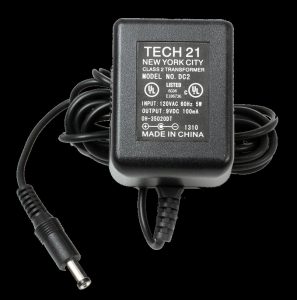 You should always use quiet designed-for-audio power supplies from reputable sources, like Boss, Dunlop, Fulltone, etc.
You should always use quiet designed-for-audio power supplies from reputable sources, like Boss, Dunlop, Fulltone, etc.
A real ground-isolated Class 2 Transformer is best. The simple ones are known as “wall warts”. Those we have tested are as quiet as a battery!
.
Please note, a real transformer will be heavy and bulky. This is why they are referred to as “wall warts”.
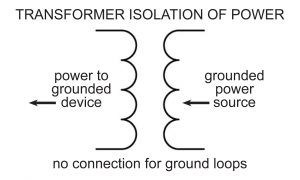 But a real transformer is the only way to fully isolate and prevent ground loop hum.
But a real transformer is the only way to fully isolate and prevent ground loop hum.
As with all power supplies, a wall wart will have a current rating, which tells you the maximum current the supply will deliver without noise.
For standard pedal-audio wall warts, this is usually no more than 200 mA (printed on the label), which will power 4-6 typical 9V stompboxes.
NOTE: PedalSnake’s 500 mA SnakePOWER supply is an exception. See below.
.
You can get lightweight “high current” pedal power supplies that deliver 1000mA or more. But a real “heavy iron” transformer is the only type power supply that will truly isolate and prevent ground loops.
In general, a good wall wart, with its isolated transformer, usually exhibits quieter operation than the high-current supplies (at least those we have tested).
Most of the time however, there is nothing wrong with using high current supplies. But if you play high gain, you may notice a bit less noise with a real isolated transformer.
A damaged power supply
Even if the noisy supply is a good brand, and it works, and you seem to be using it properly, it could be damaged in a way that makes it noisy. In this case, you just need to replace it.
.
The one thing you can do to ensure long life of a power supply, is to not overload it by putting too many pedals on a power chain.
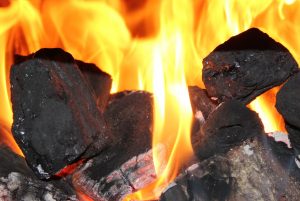 Drawing a lot of current from a supply will cause it to run hot, which will shorten its life. It may not die immediately, but noise filters or other components could be damaged.
Drawing a lot of current from a supply will cause it to run hot, which will shorten its life. It may not die immediately, but noise filters or other components could be damaged.
To ensure long, quiet life of a power supply, you should know its current rating (in “mA”, printed on the label). Then try to not exceed 50% of that, 75% at the most.
How do you know how much current your power chain is drawing? See
An overloaded power supply
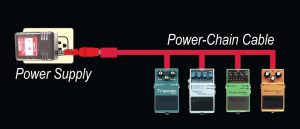 Like a power supply not designed for audio, an overloaded supply can cause HUM or BUZZ (or other nasty sounds that we have no name for).
Like a power supply not designed for audio, an overloaded supply can cause HUM or BUZZ (or other nasty sounds that we have no name for).
If you are using a power-chain, start removing pedals from the chain, and see if the noise subsides.
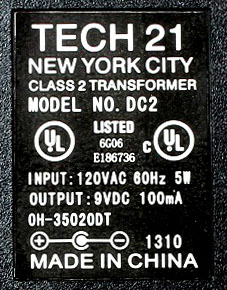
If it does, you may have been exceeding the rated current draw for that power supply (printed in “mA” on the supply). You can add another supply to ease the load on the first one, or upgrade to a supply with a higher current rating.
See Power Chaining if Fine (When Done Right).
NOTE
It is hard to know how much current your pedals really draw. A 9V pedal (that has a battery option) can draw as little as 1 mA, or as much as 75.
If you don’t know the actual current draw (and you probably don’t), we say to assume 25 mA per pedal. This is a good average to use when adding up the mA draw of all your pedals.
If you want accurate info about current draw, Stinkfoot.se has a site with The Power List, which is fairly extensive list of pedals and the mA each draws.
Or you can measure the current, or have a tech try to do it. Stinkfoot is happy to report any new info you discover.
>
With this mind, you should not come too close to the current rating of the power supply, even if it remains quiet. The mA current rating is just the maximum it can deliver, like the horsepower rating on a car engine.
A good rule of thumb is stay in the 50-75% range, or less. This means 4-6 average stompboxes on a 200 mA supply. Then the supply won’t heat up so much, and will last longer.
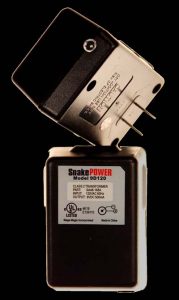 .
.
But 4-6 pedals is not a lot. This is why PedalSnake decided to offer SnakePOWER. At 500 mA, the 9D120 SnakePOWER supply has the highest current rating of any single-output 9VDC isolated Class 2 Transformer.
This is enough juice to easily and quietly power 15-20 typical 9V pedals.
.
Please know, PedalSnake will always be customer friendly. We try to make life easier for guitar players, not exploit them. We do not promote myths, we dispel them. We do not promote wall warts because we sell SnakePOWER. We sell SnakePOWER and promote wall warts because when used properly, they are the best, most cost-effective solution for having quiet power in your rig.
A power supply too close to a pedal
It is a simple trick to filter electrical noise out of a power supply. These filters do not cost very much.
But radiated noise is another matter.
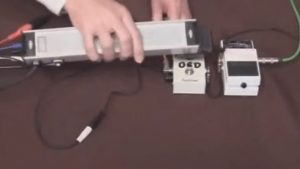 Any power supply will emit a certain amount of electromagnetic interference (EMI). When placed to close to an effects pedal, you can hear the effects.
Any power supply will emit a certain amount of electromagnetic interference (EMI). When placed to close to an effects pedal, you can hear the effects.
At the PedalSnake Channel on YouTube, we demonstrate this. At about the 0:35 mark in P-Lines and Power, you can see and hear what we are talking about.
There are expensive pedalboard-mounted power supplies available now, which are designed to be quiet near pedals. They employ toroidal transformers, which radiate less EMI.
But wall warts can be just as quiet when used properly. See Do I Need An Expensive Power Supply?
/
